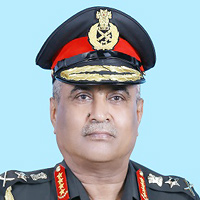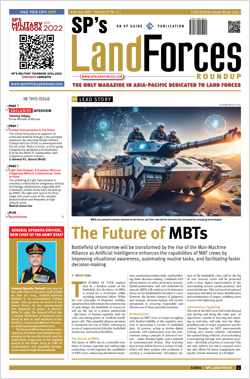INDIAN ARMED FORCES CHIEFS ON OUR RELENTLESS AND FOCUSED PUBLISHING EFFORTS

SP Guide Publications puts forth a well compiled articulation of issues, pursuits and accomplishments of the Indian Army, over the years

"Over the past 60 years, the growth of SP Guide Publications has mirrored the rising stature of Indian Navy. Its well-researched and informative magazines on Defence and Aerospace sector have served to shape an educated opinion of our military personnel, policy makers and the public alike. I wish SP's Publication team continued success, fair winds and following seas in all future endeavour!"

Since, its inception in 1964, SP Guide Publications has consistently demonstrated commitment to high-quality journalism in the aerospace and defence sectors, earning a well-deserved reputation as Asia's largest media house in this domain. I wish SP Guide Publications continued success in its pursuit of excellence.
- Interim Defence Budget 2024-25 — An Analysis
- Union Defence budget 2024
- Indian Army: In quest of greater firepower and policy recommendations for gaps
- Indian Army Annual Press Conference 2024
- 6G will transform military-industrial applications
- Tata Boeing Aerospace Delivers 250 AH-64 Apache Fuselages, Manufactured in India
Exercise Yudh Abhyas 2012
By SP's Special Correspondent |
||||||||
| Indo-US troops interacting with each other | ||||||||
 |
||||||||
| Close cordon of insurgent hideout | ||||||||
 |
||||||||
| Closing on to the insurgent hideout | ||||||||
 |
||||||||
| Estblishment of the cordon around the abandoned village
March 20, 2012: The Indo-US land forces engagement has progressed substantively. Starting at the first Yudh Abhyas exercise seven years ago at the basic platoon level, the exercise held this year has evolved into an advanced command post and field training exercise.
Spread across two locations under the Army's South Western Command since early March, this years Yudh Abhyas involves a US Army contingent from the US Army Pacific (USARPAC), part of their Pacific Command (PACOM) and troops from the 2nd Squadron 14th US Cavalry Regiment from 25th Infantry Division, Hawaii, along with a platoon of Strykers. The Indian Army fielded a similarly-sized mechanized infantry unit. According to the Army, "The event is all the more interesting as a number of key surveillance, communications and Improvised Explosive Devices detection and neutralisation technologies, available with both sides have been fielded in the exercise." The exercise involved several key elements of close joint engagement for offensive objectives. For instance, as part of the field training element codenamed Desert Lark, troops from both sides performed a joint cordon and search drill to neutralise suspected insurgents in a specially constructed training area at the ranges in an abandoned village in the Mahajan Field Firing Range in Rajasthan. The dramatic drill had the Indian and US troops establishing a physical cordon by deploying their respective combat vehicles at night, followed by a ground push by troops to zero in on and flush out insurgents. Helicopter support was part of the drill for injection and evacuation of the crew, and to provide air support. Several elements of the drill were reminiscent of the final manoeuvers employed during Operation Neptune Spear, the mission that eliminated Al Qaeda chief Osama bin Laden in Abbottabad, Pakistan. It may be noted that a similar manoeuver was also performed by Indian Army troops at Exercise Vijayee Bhava last year in Rajasthan.
The command post exercise, codenamed Sarvada Saviours, which took place at Bathinda focused on a major area of interest for both armies — explosive ordnance and IED disposal in a hostile environment. The exercise involved sappers from both sides and dealt with the innumerable challenges they face in countering the assymetric threat posed by IEDs and street-side bomb attacks. The non-operational element of the exercise involved infrastructure development in strife torn regions and inaccessible areas and, crucial to both sides, the execution of rescue and relief operations during natural calamities. According to the Army, the command post exercise in particular provided an excellent opportunity to both sides to understand functioning of Engineer Brigades with special emphasis on operations under United Nations mandate in troubled areas. DESERT LARK and SARVADA SAVIOURS was witnessed by an Indian and US Army delegation, headed by Lt Gen Gyan Bhushan, GOC-in-C South Western Command and Lt Gen Francis "Frank" Wiercinski, commander of the US Army Pacific, as also the co-chair of the Executive Steering Group (ESG) for Indo-US army training events and exchanges. The weapons and systems involved at Yudh Abhyas included Stryker special vehicles, anti-armour and infantry weapons from the US side. The Indian Army fielded BMP armoured personnel carriers, IAF Mi-17 helicopters and support systems. As with the earlier iterations, the current Yudh Abhyas combat drill has been designed to promote cooperation, interoperability and operational understanding between the Indian and US land forces at the tactical level, with a strong and evolving focus on sharing training procedures and building joint operating skills, within the framework of UN peacekeeping operations. |









